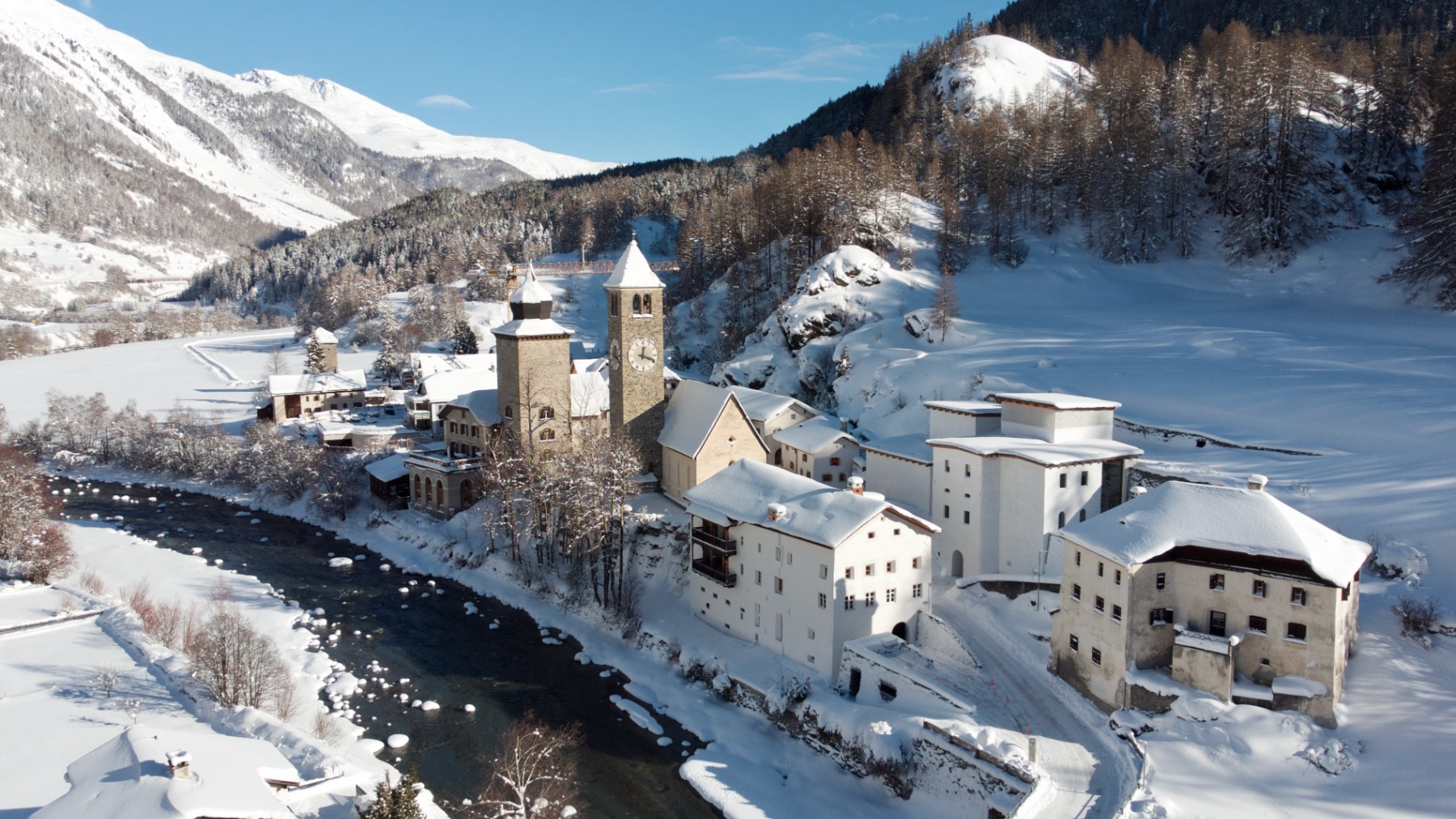
Art paves the way
An interview with art collector Grażyna Kulczyk
Adriana Prodeus
Grażyna Kulczyk is a Polish entrepreneur, patron and founder of Muzeum Susch in Swiss Engadin Valley. Grażyna Kulczyk's collection is the biggest in Eastern Europe. Focused on conceptual art and works by female artists with a natural input from the region, it aims to redefine the canon of art today. In 2004 Art Stations Foundation, by Grażyna Kulczyk was established at the Old Brewery in Poznań, Poland. The philosophy of 50% art and 50% business has provided the basis for a conscious building of an institutional program to promote knowledge about art and culture within a commercial setting.
Such Muzem hidden high in the mountains it used to be a monastery (since 12th century) and brewery (since 19th century) until it opened in 2019 as an art space, restored and expended by Swiss architects, Chasper Schmidlin and Lukas Voellmy. Once situated on a pilgrim's path just in the middle between Rome and Santiago de Compostela Susch serves now as a temple to contemplate art, as a laboratory for research and an agora for argument with art. It consists of permanent, site-specific installations by international contemporary artists and also of exhibitions of underrepresented women artists, building a matrilineage of history of art.
I just came back from Susch and I think that without experiencing this trip, I would have had a completely different vision of this museum. Why did you choose such an unusual place for your institution?
It looks like a fairy tale, doesn’t it? Snow-capped mountain peaks, the bridges over the rushing rivers, the tiny villages amidst the tree-covered valleys, and those shiny red trains slithering through the landscape. It is hard to think of a more picturesque excursion, and I wanted to make it part of the art experience. The museum was meant as neither a mere container for the artworks, nor an architectural-ego space cruiser.
(© Claudio Von Planta courtesy Muzeum Susch, Art Stations Foundation CH
It is an artwork in itself.
Yes, and at the same time it is not the place for displaying my collection. I wanted to create a space unlike any other, bring a different approach to private art initiatives, which is not only to create a public space for art, and a complex one at that, but also to create a sustainable way of exhibiting work – ‘slow art’. Unlike in the Old Brewery in Poznań – the revived post-industrial urban block – which was meant to intensely mingle retail with cultural activities. While I neither conceive nor curate exhibitions, I do enjoy speaking with curators. Although I have been collecting for years, it would be reckless if I tried to organize an exhibition myself. Shaping the DNA of the museum as well as developing my own collection is challenging enough. A discussion about art requires a public space as well as specialists who can conduct this kind of debate. At the same time, I do encourage curators to use my collection as a possible source of inspiration. Every now and then, a work catches their attention and is included in the narrative of the show. Some have clear ideas how to make use of the collection, but exhibitions can also do without these artworks altogether. My collection is not at the centre.
© Andrea Badrutt, Chur. courtesy Muzeum Susch, Art Stations Foundation CH. 
Will it ever be presented?
I don’t think so. The space constraint is just one issue. Some years ago, around 100 artworks from my collection were presented across some 3000 square metres at the Fundación Banco Santander in Madrid in the exhibition Everybody Is Nobody for Somebody. I then realised that it would be impossible to ever display this collection to a significant extent, not to mention the whole. However, if there had been an idea for an overview with an interesting trajectory, I’d be glad to consider it.
© Andrea Badrutt, Chur. courtesy Muzeum Susch, Art Stations Foundation CH. 
How many artworks are in your collection?
Close to a thousand and it is still growing. As it is impossible to display as a whole, I did not plan the museum as a space for it. Originally, Susch was meant as a counterpart to a museum project I had planned for Warsaw. An outpost abroad where art would be discussed by experts. But this was a short-lived idea, since building the museum in Warsaw proved unlikely. This is when I realized that Susch would be a fully-fledged undertaking.
So, the Warsaw project will not come to pass?
I don’t think so, there was little initiative among the people dealing with visual arts within the city hall. I no longer live in Poland, so I don’t follow the recent moods, but as far as I know, it seems that there is still a long way to public–private partnerships. Moreover, visual arts are a challenging field. With operas and theatres struggling in Poland, and those have, historically, a much richer tradition, visual arts are in a tough spot. The majority of people in Poland are not prepared to engage with contemporary art. It will take years for the Polish authorities to acknowledge the importance of education with respect to art. And yet the whole world communicates with the help of the arts in its different aspects: intellectually, socially, financially. Not just Western Europe or the United States. In recent years, Asia opened up to contemporary art. But in Poland it is still frequently marginalised.
What was the Warsaw museum supposed to look like?
Along with presenting parts of my collection, the idea in Warsaw was to make works by significant foreign artists available to the Polish public, the architectural design was also meant to involve one of the major architects. At that time, I thought of Susch in quite the opposite way: as a small, experimental place focusing on Polish artists. The museum was supposed to be, to put it bluntly, an unprecedented act of patriotism.
While now it is a space of dialogue between artists from many countries. Visiting the museum, I got the impression that it was no coincidence that you chose the Engadine Valley as the home for it.
It is hard to imagine a place where people would be better prepared to engage with art. This tradition is very much alive here. Still, we should remember that we are in a village in the Engadine Valley, not in a city like Basel or Zurich. Susch is a tiny village, and its residents had to face quite a challenge in order to enter into a dialogue with the museum. And it wasn’t really obvious if this dialogue would succeed. Nevertheless, I don’t think I would ever dare to present such a socially bold programme in some remote Polish village. Engaging with art is deeply rooted in Switzerland’s tradition, the public is well prepared and the Engadine is home to art galleries as well as collectors. It is far from an artistic desert.
© Andrea Badrutt, Chur. courtesy Muzeum Susch, Art Stations Foundation CH. 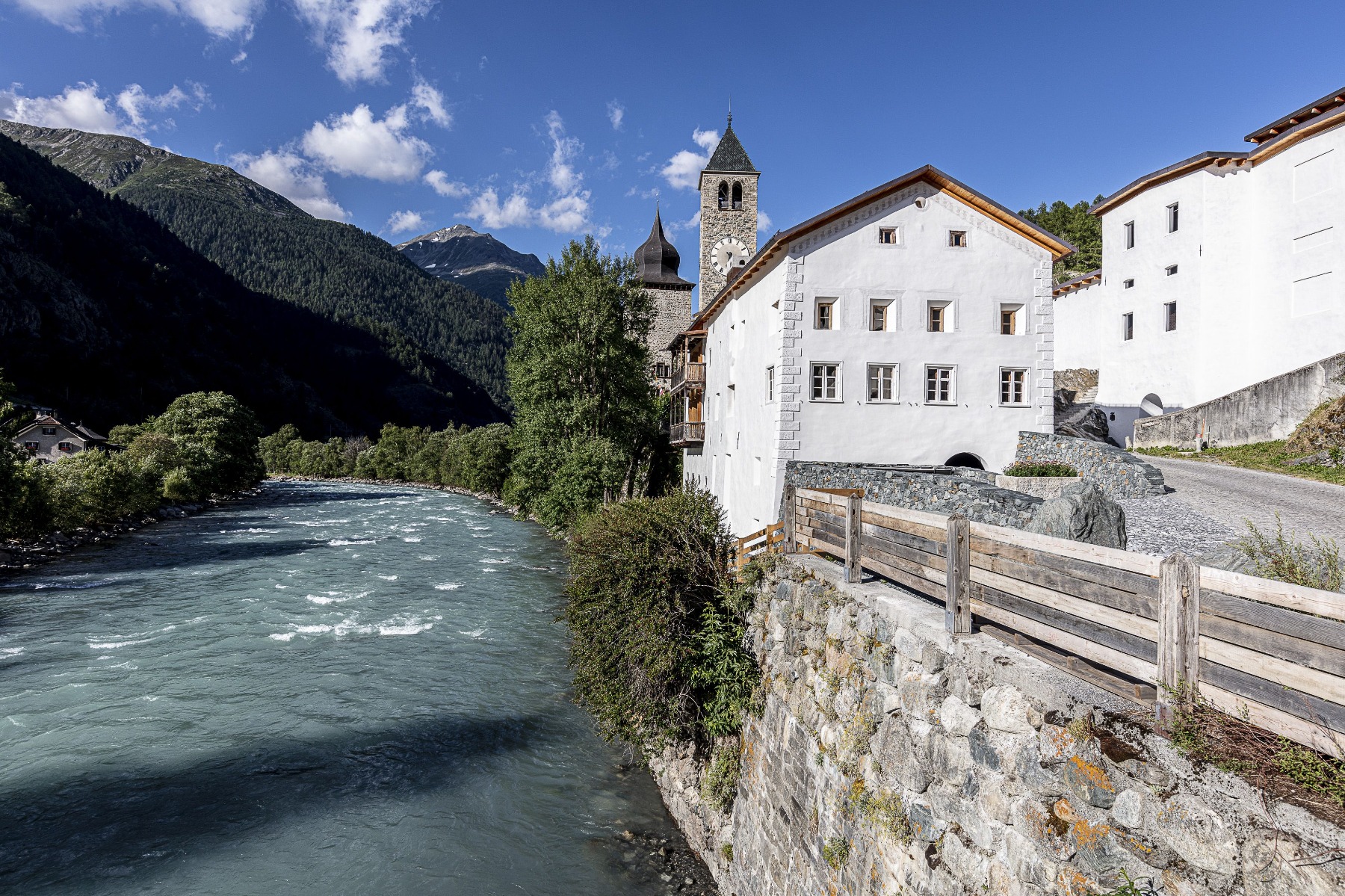
I might be exaggerating, but chances are that there one would find more people interested in contemporary art in the Engadine Valley than in Poland.
That sounds amusing, but not impossible. People here visit exhibitions and approach artworks seriously. To date, Susch has been visited by 30 thousand guests. A turnout similar to that, say, of Migros Museum in Zurich – but it is a large institution, recognized for years, while Susch is a newcomer in a remote area. I therefore think that Muzeum Susch achieved massive success within the first year of its activities. A lot of our visitors come from all over the world. The awards it received came as a nice surprise on top of that. I was recognised as the European culture investor of 2019 in Essen. The Guardian listed us among the 25 most interesting buildings of the 21st century, while TIME magazine considered us in the top 100 most interesting places of 2019, we also made the shortlist for the Leading Culture Destination Award. That’s something to be proud of. When I was beginning the construction, nobody promised this would be a success. I rather had the impression that quite a few people thought that some crazy Polish woman pursues an insane idea somewhere in the Swiss mountains. I had a similar experience during the construction of the Old Brewery in Poznań, which today is an important space that reconfigured the entire city centre. First there was mocking comments and criticism - why would one renovate and build such a massive structure which required a new design of the street grid. It is easier to be an art collector than a patron. When you go out into the public sphere with art, you can run into challenges. Anyway, the word ‘patron’ itself has been discredited for years in Poland. But I do take it seriously - devoting my own money, time and energy to ideas that engage with the audiences.
The Engadine Valley residents came to appreciate it.
Indeed. I was surprised by their enthusiastic feedback. So many people from the local community were engaged in the Muzeum Susch. Together with the architects and curators we tried to make it clear that I did not want Susch to be a vanity project. Rather it is an institution for the public, a shared space in which the people can participate. They did come to appreciate it in the end, but it wasn’t easy. They had to bear three years of noise, dust and access restrictions. Fortunately, my presence on site, managing the construction literally every day, and my commitment helped convince them. My business background proved helpful: being close to people helps them to accommodate big changes. Plus, I appreciated working with local craftsmen, all of whom received lifetime free admission to the museum for themselves and their families.
Mirosław Bałka, NARCISSUSSUSCH (2018) (c) Studio Stefano Graziani, courtesy Muzeum Susch, Art Stations Foundation CH. 
Names of many of them are carved on the side of tabletops in the museum bistro.
The tables were commissioned by the craftsmen who felt proud and grateful to have participated in the whole undertaking. Once the construction work was finished, I still wasn’t sure how the people would react to the first exhibition. Most of the artworks we presented were daring. But the residents of Susch were the first ones to see the inaugural exhibition, before the official opening, and before long they felt as co-hosts. They call it ‘our museum’ which is the best compliment.
This reminds me of what happened in Poznań 20 years ago when you created the Old Brewery in the city centre. But that concept was seemingly easier as the spaces for art were neighbouring with a shopping mall.
In both cases, Susch and Poznan, the heart of the project was the renovation of a former brewery building where I intended to display works of art. But in Poznań it seemed more tangible. Here in Switzerland, it took an enormous imaginative effort of the architects and myself to shape the spaces in their present form. From my experience in Poznań I already had an idea of the scale of the project. While the renovation of the first building was underway, I purchased the neighbouring ones. The plans developed as we worked.
Large scale seems to be in your nature.
It feels it is in my DNA, I like to think big. I dreamt of a museum and this dream came true in Susch. And I never intended it to be commercial undertaking. I fulfil my professional ambitions in business while art is something I embrace. I don’t want to link something that I love with earning money.
Up to And Including Limits: After Carolee Schneemann. Chicks on Speed (Federico Visi, Alex Murray-Leslie wears EMG BioMuse 4 by Prof. Atau Tanaka, with assistance by post doc researcher Federico Visi. High heeled shoe Guitar). /
Photo: Silke Briel. Courtesy Muzeum Susch / Art Stations Foundation CH 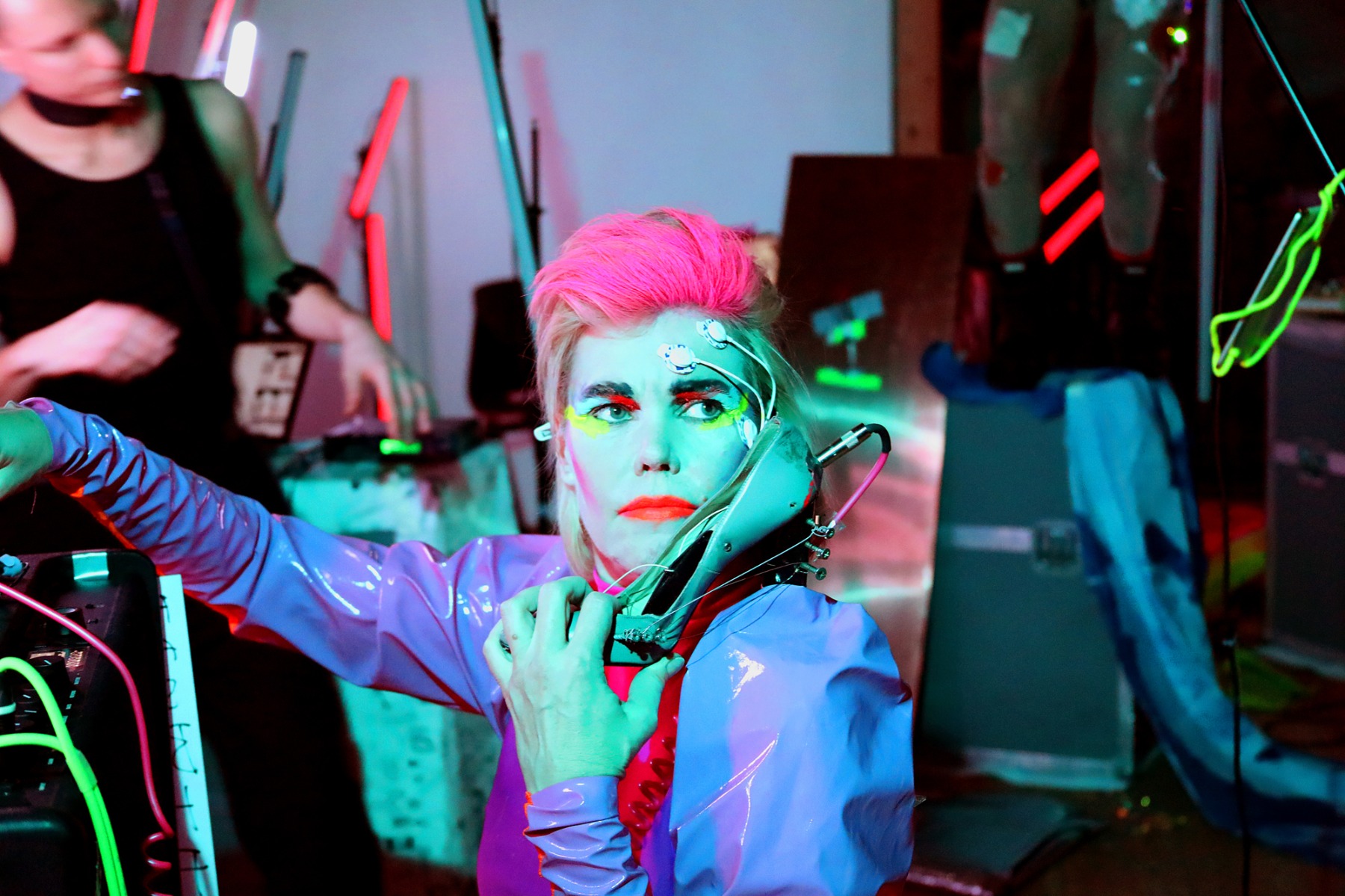
From the beginning you also supported dance and performance. You were the first one in Poland to create a space for these activities – in the Old Brewery. Today, dance and performance works found their way into the majority of museums. You anticipated that years ago.
It is a challenge to collect performing arts since nothing can replace the presence, participation and contact with an artist. But it is too important a branch of art that to be omitted.
Performing arts remind us that there are artworks that cannot be possessed.
A performative artwork is essentially about the experience of a living person. What we are dealing with here is immateriality that needs to be mediated.
Up to And Including Limits: After Carolee Schneemann. Chicks on Speed (Cyborg Alex Murray-Leslie wears EMG BioMuse 4 by Prof. Atau Tanaka, with assistance by post doc researcher Federico Visi. LED system by GarageCube). / Photo: Silke Briel. Courtesy Muzeum Susch / Art Stations Foundation CH 
While collecting is always connected with a desire to possess. When did you start to be a collector?
I couldn't describe myself a collector from the point when I started buying art. In order to be an art collector you need to have a philosophy, choose your own path. Purchasing artworks, even when one takes a keen interest in them, is not collecting. You need to acquire knowledge, awareness, and know why you do it and what is the purpose of the art you collect. If someone spends money on art to improve their self-esteem or to prove something to someone else, I don't think they are collectors.
When did you truly become a collector?
The turning point was the exhibition in the Old Brewery in Poznań in 2007 curated by Paweł Leszkowicz. He managed to identify and juxtapose important works from my collection, and when I saw them coming together, I managed to trace those connections. It was a kind of a reappraisal of what I collected thus far. It made me reconsider many things. From that point I was increasingly aware about my art purchases.
And before that?
I started buying art in the 1970s still as a student, it felt like a natural continuation of being around artists and intellectuals. After that I began buying art for more for decorative purposes, to compliment the bourgeois interiors, rather than to experiment. Although at that time I was considering every purchase in terms of the artist's contribution to Polish art – as I was collecting only works by Poles. The turning point was my first purchase of a work by a foreign artist. This was a work by Antoni Tapies which I acquired at an auction at Sotheby's. I then realized: I could be more bold. I started to look for contrasting positions to Polish art in my collection, though that alone didn't make me a collector yet. In Poland, people don’t buy too much foreign art, which is what made my collection there exceptional. Sadly, it is also not common to exchange information about what the collectors own, not to mention presenting the works. I tried to change this but didn’t succeed. I feel I only became a collector after I changed my perception of how I wanted the art to influence people and how I wanted to share it.
In the Old Brewery in Poznań, one could tell which works are your favourites. The Blow Up Hall hotel was created around the installation by Rafael Lozano-Hemmer. In Susch, a whole tower was built around a 14-meter-high sculpture by Monika Sosnowska. Is that the logic you follow?
Indeed, one could get the impression that, in terms of logistics and architecture, Sosnowska's work is crucial for Susch blending into the building structure. It was created when the building was not yet finished, and things were still in disarray. If this sculpture could speak it would tell a lot! It witnessed the subsequent stages of construction: the removal, the restoration as well as the creation and merging of new and existent spaces. Due to its sheer size the sculpture had to be installed at an early stage, and the museum was built around it. In a way, it was also important for me to be able to work with Monika Sosnowska. Before that, whenever a museum-quality work of her caught my attention, there was someone who was faster than me. So, I decided to commission a large work directly.
Other works also arrange the space, each is displayed separately.
In Susch each room exists in itself. I placed Sosnowska's Stairs as the centrepiece, but right next to it sits Herrenzimmer by Heidi Bucher, which is the result of a completely different thinking process. This installation represents a room which women were not allowed to enter. Two strong women artists meet in neighbouring geographical and temporal spaces and have a lot to say to each other. I am very pleased that you can observe both of these spaces simultaneously. Still, I don't have a favourite piece. Each work displayed in Susch has its distinct story. I am also proud that I found such a wonderful place for a group of sculptures by Magdalena Abakanowicz. This space which, reminiscent of a chapel, seems to enshrine this crowd of figures. While the meaning of this work remains universal, I like to give artworks a new context in the space. We develop as people, I change as a collector, and it's always good to look at something in a new way.
Can you name an example?
I have a special relation to the works of Roman Opałka. I had the rare opportunity to be considered his friend and witness how he worked. Some collectors are friends with artists, they visit their studios, they are proud know them. With me it’s different, my acquaintance with Opałka is an exception. I still remember vividly how he held the brush, how the canvas and the whole workplace were arranged, how he planned the technical aspects of his studio, which was important due to his age, and helped him to paint these minuscule numbers. I remember the conversations with him, minor situations which helped me to know him as a human being. I regret that he is still so little known. There are very few artists who embarked on such a precise, consistent path and created a body of work of this scale. I do believe that one day Roman Opałka will be recognized as a great artist of his generation.
The art world is ruled by certain fashions, but you seem to resist this. How do you manage to do it?
It’s not easy to convince me now and I don’t fall into a rush of admiration. Every year I sense the changes in what the market offers, I am increasingly critical in my judgements. I used to visit fairs or auction houses and would want to buy a several works immediately. Now I have a different approach, but the art market has also changed.
Why? How it has changed?
Most of the interesting artworks are not easily available. The historical works offered to art collectors, or those who simply buy art, is frequently of secondary or inferior quality. And there are, naturally, many works created by young artists. But I must admit, I am not yet convinced by a huge portion of the art created by the youngest generation.
So how do you buy art currently? Do you visit the fairs?
I do visit art fairs, because it is like a feast to me – I enjoy meeting gallery owners that I know, curators, and other art aficionados. And you can still find works that merit attention.
Currently your collection is much bigger and your expectations much higher. During all those years you have met many influential people in the art world. For instance, the curator and critic Anda Rottenberg has been an important person for you. Do you still have people you look up to?
Anda Rottenberg is an unquestionable authority for me. I consider her a friend, we also talk about art, however she has never been my advisor. Our friendship has roots in different experiences and art is not the most important thing in it. There were other people, too, on my collector’s path who acquainted me with a number of artists and gallerists. But I am guided by my own choices. I don't claim the rights to professional knowledge and I still don't have enough time to devote myself to studying art in full depth, but I appreciate listening to what people who are experts in the field have to say. This is probably what most collectors with entrepreneurial background do. Hopefully, I will live long enough to explore topics that have long interested me in art. Meanwhile, I'm listening to experts, the real ones, because without refreshing knowledge, discussion, research, even the greatest minds wither. Still, I draw my own conclusions and ultimately whether I purchase something or not is my sole decision.
Do you like to share art or are there works that you want to keep exclusively for yourself?
There are works I would prefer to stay in close contact with. And there are also those I would rather not part with but still, they travel to exhibitions and sometimes I don't get to see them for several years. But sharing artworks also depends on the initiative and commitment of museums and galleries.
What art do you live with on a daily basis?
I can't imagine a day without being in contact with art. Apart from the works I live with, I am at the museum almost every day. No matter what, I engage with art on a daily basis. But there are also works in my collection I couldn't imagine surrounding me every day.
Up to And Including Limits: After Carolee Schneemann. Aura Rosenberg, Astrological Ways (2012), installation view. Photo: Maja Wirku
And what characteristic features should an artwork have to make you feel like having it at home?
It should be something that makes living with it somehow uneasy. These are works I like to argue with, they stir tension, make me think. If something is an enjoyable colourful composition, visually appealing or very well executed, this is not enough. The obvious thing doesn’t give me the kicks. For instance, Maria Jarema, an artist I adore, believed that the idea conveyed in the picture changes the moment the artist attempts to explain what inspired her, not to mention when we try to arrive at our own interpretation. An artwork continues to change, and I prefer to have my own reading. That’s how I understand art: it gives you the opportunity to develop your own interpretation. At the same time, in order to do it, you have to learn its language.
Every now and then, the businesswoman in me gets the better of me. I also read a lot about artists, especially those whose works I’ve had for years and who are receiving their due recognition only now and are shown in the largest art institutions across the world. Nothing pleases me more! This is rewarding and proves: I’ve made a good decision. I do not follow trends. The museum and the program we develop there is the best proof. For instance, Emma Kunz has been such a discovery! I am very glad that thousands of people visited her exhibition in Susch. For me, the museum is a laboratory where you can create an artistic universe. At the same time, I know that even the most beautiful museum has little chance to keep the audience interested without impactful, exciting and well-planned exhibitions. I knew that the construction process itself was difficult, but I also see now that every year I will need to put more and more effort for Susch to continue to remain an appealing place.
In addition to managing the museum, you are still a collector. Why do you need art now at personal level?
With the museum I have achieved my goal, but I love art outside the museum context too. Collecting is addictive. Over time I became picky but I still buy, and am excited when I have the opportunity to discover an artist I didn’t know before.
Up to And Including Limits: After Carolee Schneemann. Kris Lemsalu, I Will Be Seven When We Meet In Heaven (2016), installation view. Photo: Maja Wirkus 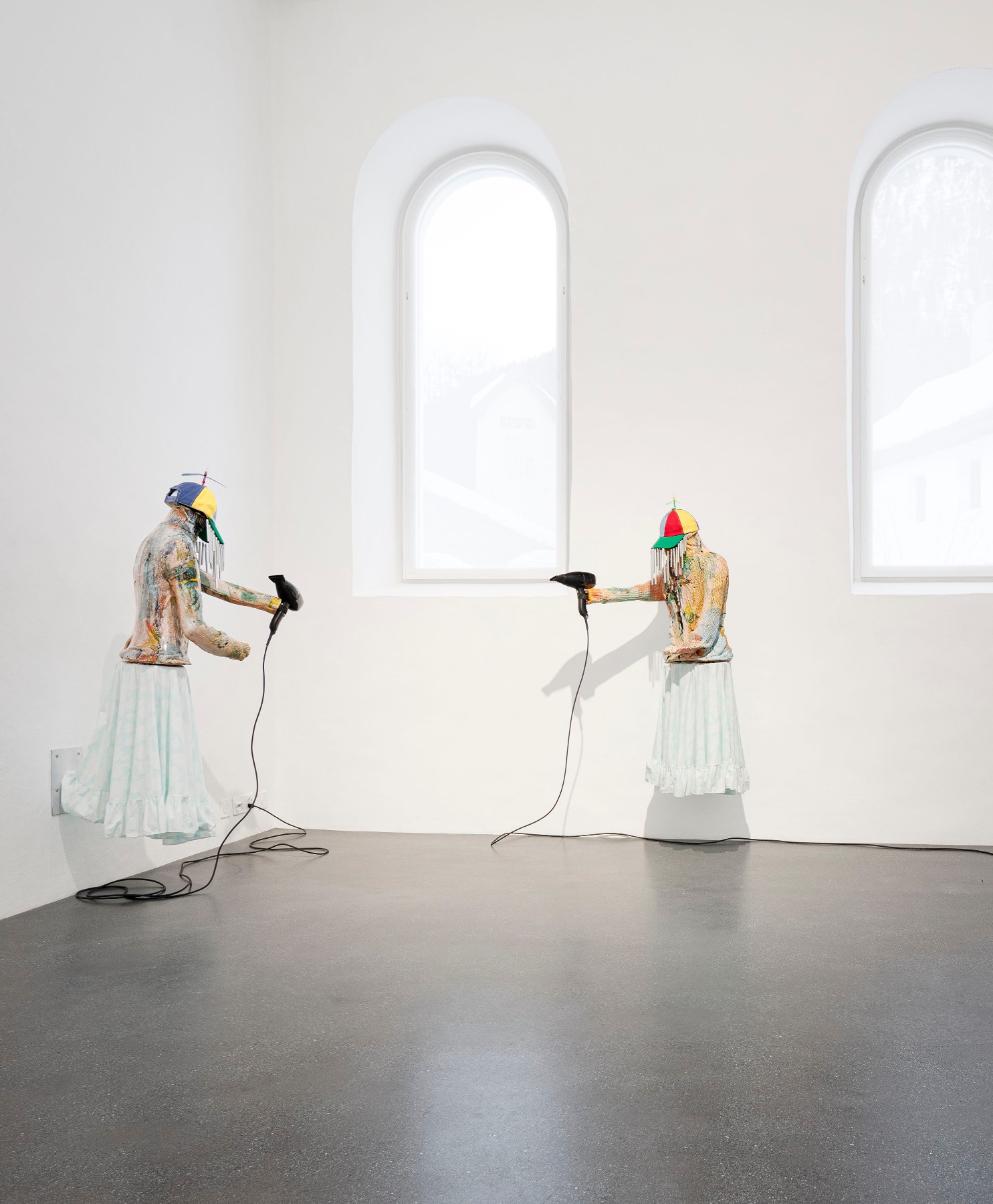
Do you still happen to see something and buy on the spot?
Yes, but rarely. When I decide not to buy, I might regret that lost chance and then, when I come back after a while, the prices may have gone up. But you shouldn’t regret that you did not buy when you feel you’ve had taken the time to consider the purchase. Some acquisitions need time.
You are known for collecting art by women. In Susch the majority of the works on view are by women artists. Do you have a special focus on them?
I have always been conscious of the differences in perception of what men and women do in every field, not just art. In business, I never came to terms with the fact that women were treated as inferior, despite their skills or talents. And in my companies, I employed mainly women. Women artists are just as neglected as businesswomen, women doctors or women engineers. So, who, if not a woman collector, should focus on women artists? Nowadays, when women's art is in fashion, men will buy several women's works purely out of principle. True, but I’m not sure if these purchases are rooted in actual convictions and a belief in the artistic value of these works. And I decided that I this is precisely what I would like to be at the core of my collection. I think of this as my duty. Time has shown that works by a number of women artists which I had taken interest in were also appreciated by experts and the art market. In many marriages or artistic relationships, the woman received recognition only much later. Heidi Bucher gave birth, cooked, raised sons, and created art in her spare time. Now serious cultural institutions are interested in her practice. My idée fixe is to help reconsider the position of women in art history, one might call it a matrilineal approach. And there is a lot to be done. The next exhibitions in Susch will also be devoted to women: Carolee Schneemann, Evelyne Axell, Laura Grisi.
Up to And Including Limits: After Carolee Schneemann. Katrina Daschner, Pferdebusen, 2017, video still, courtesy the artist and Sixpackfilm Vienna 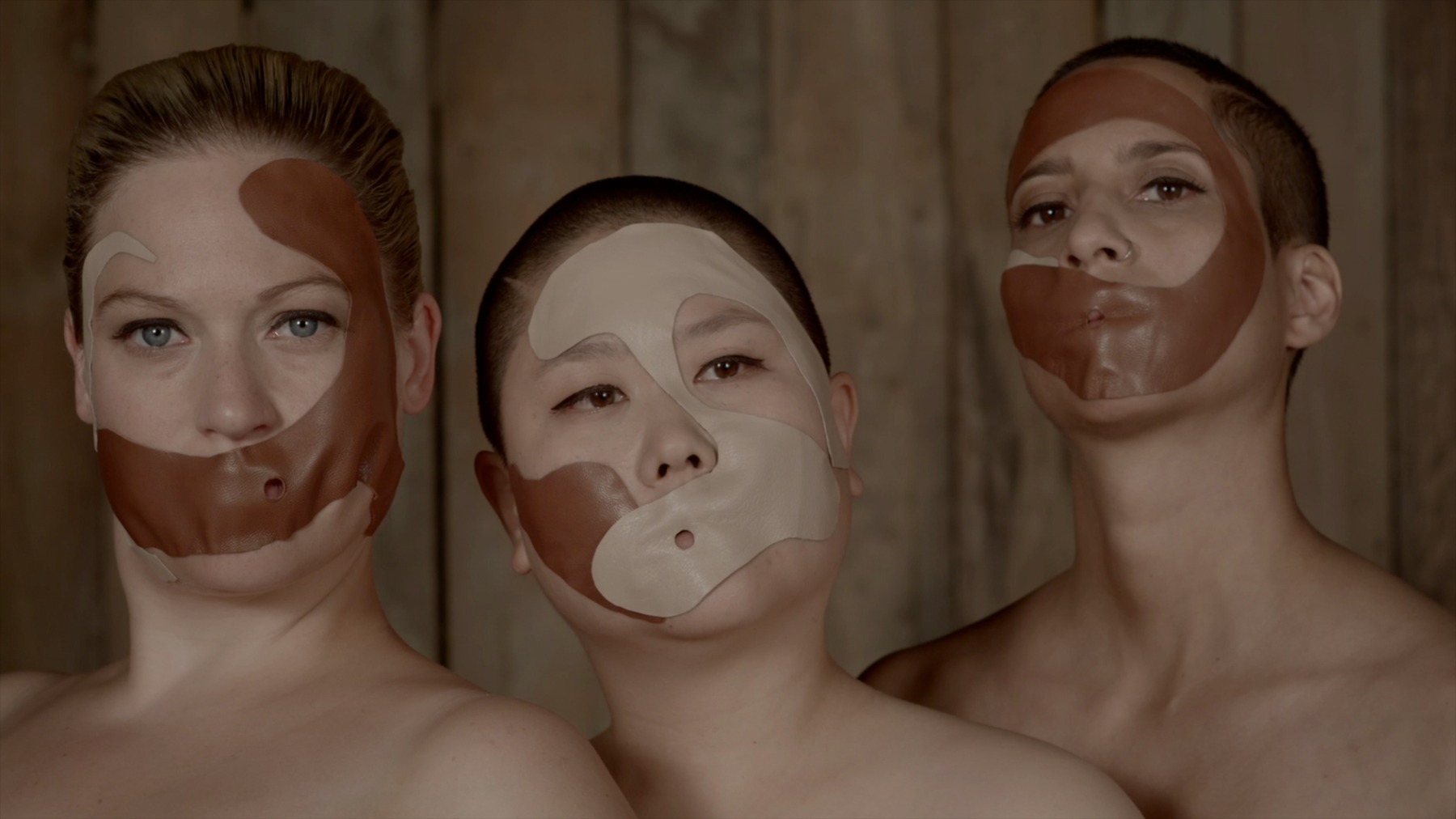
When you were building the Old Brewery in Poznań, there were comments in the media about whose wife you are, that you were bringing up children, going shopping, and at the same time you were developing an art collection and exhibitions.
It sounds a bit similar to what you say about women artists. Feminism has to begin with women supporting other women. This is the biggest challenge. If women don’t appreciate each other, patriarchy will not budge. Madeleine Albright once said that there is a special place in hell for women who did not support other women.
We got ourselves talking about women and we were supposed to discuss art…
Art is ahead of many subjects and paves the way towards many things. It is often this sensitive seismograph that captures changes around us, but at the same time it is extremely fragile itself. Each important thing in our lives is manifested in art and that is why I love it so much.
